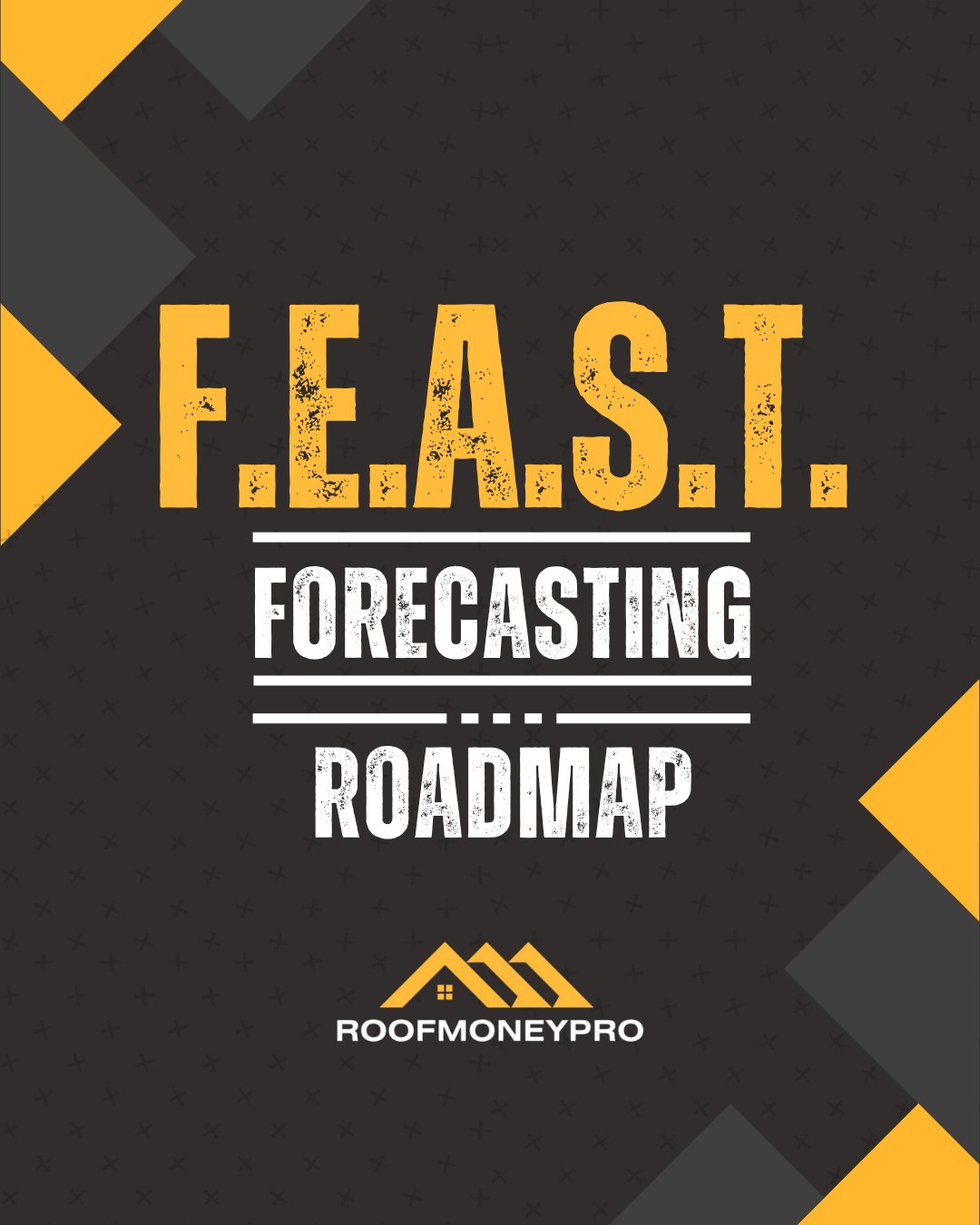Emergency Savings vs. Debt Repayment for Roofing Professionals: The Complete Strategy
Oct 23, 2025
Here's a sobering reality: 57% of Americans can't cover a $1,000 emergency expense without going into debt.
For roofing sales reps and contractors dealing with seasonal income fluctuations, equipment failures, and unpredictable cash flow, this statistic hits even harder.
Your work truck needs a $2,500 transmission repair during slow season. Do you:
- Drain your savings account completely?
- Put it on a credit card at 24% interest?
- Take out a high-interest personal loan?
Or do you have a strategic plan that handles both emergencies AND debt payoff?
As a roofing professional, you face unique financial pressures: storm season feast-or-famine cycles, expensive equipment maintenance, delayed customer payments, and the constant temptation to finance every truck upgrade or tool purchase.
Let's break down a practical approach helping roofing sales reps and contractors tackle both emergency savings and debt repayment strategically—without sacrificing your sanity or future wealth.
Understanding the Emergency Savings vs. Debt Dilemma for Roofing Professionals
The Brutal Question Every Roofer Must Answer
If you lost your income tomorrow, how long could you survive?
For roofing professionals, income interruptions aren't hypothetical:
- Injury on the job sidelining you for 3-6 months
- Slow winter season cutting commissions by 60-80%
- Economic downturn freezing residential roofing projects
- Major storm shutting down work for weeks
- Customer payment delays leaving you cash-strapped despite completed jobs
- Unexpected business expenses (vehicle breakdown, equipment failure, insurance spike)
Operating without a financial safety net creates constant psychological stress: anxiety about every unexpected expense, worry about covering payroll, doubt about business sustainability, and fear of one bad month destroying everything you've built.
Why Debt Keeps Roofing Professionals Trapped
I've known roofing contractors who perpetually carry credit card balances—announcing they've paid off the card, then six months later mentioning they're "working on it again."
Sound familiar? Here's why this cycle destroys roofing professionals:
Average credit card interest rates: 20-30%
Real cost example:
- $15,000 credit card balance at 24% APR
- Minimum payment: $450/month
- Total interest paid over time: $19,000+
- Time to pay off with minimums: 15+ years
That $15,000 in debt just cost you $34,000 total—money that could've funded retirement, bought equipment outright, or built passive income streams.
Having proper emergency savings prevents falling into deeper debt by eliminating the need to rely on credit cards or predatory loans when truck repairs, slow seasons, or business emergencies strike.
Assessing Your Current Financial Situation as a Roofing Professional
Calculate Your Debt-to-Income Ratio (DTI)
This metric gives you a 30,000-foot view of financial health—the same calculation mortgage lenders use to determine if you qualify for $300K+ loans.
Formula: (Total Monthly Debt Payments ÷ Gross Monthly Income) × 100
Example for Roofing Sales Rep:
- Monthly income: $8,000 (commission-based, averaged)
- Truck payment: $650
- Credit card minimums: $350
- Personal loan: $200
- Student loan: $150
- Total debt payments: $1,350
DTI Calculation: $1,350 ÷ $8,000 = 16.9%
DTI Ratio Guidelines for Roofing Professionals
35% or less: Excellent. You're managing debt well with money left for savings and investments.
36-44%: Manageable but concerning. Most lenders still approve loans, but you should aggressively reduce debt.
45% or higher: Dangerous territory. You're carrying too much debt for your income—one emergency could trigger financial collapse.
For roofing professionals with irregular income: Target 25% or lower DTI to handle seasonal fluctuations safely.
Prioritize Debts Strategically
Debt Snowball Method (Psychological Wins):
- List debts smallest to largest balance
- Pay minimums on everything except smallest debt
- Attack smallest debt with extra payments
- Once paid, roll that payment to next smallest debt
- Best for: Roofing professionals needing motivation and quick wins
Debt Avalanche Method (Mathematical Optimization):
- List debts highest to lowest interest rate
- Pay minimums on everything except highest rate
- Attack highest rate debt with extra payments
- Once paid, roll payment to next highest rate
- Best for: Cost-conscious contractors maximizing dollar efficiency
My recommendation for roofing professionals: Start with snowball (momentum matters), then switch to avalanche after first 2-3 debts eliminated.
The Case for Building Emergency Savings First: Roofing Industry Reality
Calculate Your Optimal Starter Emergency Fund
Step 1: Determine Essential Monthly Expenses
Example for Roofing Sales Rep:
- Rent/Mortgage: $1,400
- Food/Groceries: $700
- Utilities (electric, water, phone, internet): $300
- Transportation (gas, insurance, maintenance): $600
- Insurance (health, life): $350 Monthly Total: $3,350
Step 2: Calculate Emergency Fund Targets
- Minimum starter fund: $3,350 × 3 months = $10,050
- Comfortable safety net: $3,350 × 6 months = $20,100
- Maximum security: $3,350 × 12 months = $40,200
Emergency Fund Targets Based on Roofing Professional Type
W-2 Roofing Sales Reps (Stable Base + Commissions):
- Minimum: 3 months expenses
- Target: 6 months expenses
- Reasoning: More income stability, easier to find new sales position
1099 Commission-Only Reps:
- Minimum: 6 months expenses
- Target: 9-12 months expenses
- Reasoning: No income guarantees, longer job search if needed
Roofing Contractors/Business Owners:
- Minimum: 6 months personal + 3 months business expenses
- Target: 12 months personal + 6 months business expenses
- Reasoning: Both personal survival and business continuity required
The Peace of Mind Factor
Imagine this scenario: Your work truck transmission fails ($3,500 repair). You open your emergency fund account, transfer $3,500, pay the mechanic cash, and continue working—zero stress, zero debt, zero interest charges.
That's financial freedom. No scrambling for high-interest loans. No maxing out credit cards. No panic about covering next week's expenses.
Start Small: The $1,000-$2,000 Foundation
If you've never maintained savings before, don't aim for $20,000 immediately. Start with a $1,000-$2,000 starter emergency fund while aggressively paying debt.
This small buffer prevents minor setbacks (blown tire, minor truck repair, small medical bill) from derailing your debt payoff progress.
Once you hit $1,000-$2,000 saved, switch focus to aggressive debt elimination. After debt-free, return to building full 6-12 month emergency fund.
Automate Savings While Managing Debt
Setup automatic transfers:
- Direct deposit: Route $250-500 every paycheck to savings
- Recurring transfers: Schedule automatic bank transfers on payday
- "Pay yourself first" mentality: Savings happens before discretionary spending
You won't even notice after 2-3 months—you'll simply adjust spending to what remains in checking. This psychological hack makes saving effortless.
When to Prioritize Debt Repayment Over Emergency Savings
Scenarios Where Aggressive Debt Payoff Makes Sense
1. High-Interest Debt Above 15% APR
If you're carrying credit cards at 22-28% interest, that debt compounds faster than any emergency fund interest earnings. Attack it aggressively while maintaining minimal $1,000 starter fund.
2. Debt Consuming 40%+ of Income
When debt payments exceed 40% of income, you're one emergency away from financial disaster. Eliminate debt to free up cash flow, then build robust emergency savings.
3. Stable Income + Strong Support System
If you have:
- Reliable W-2 income with benefits
- Family who'd help in true emergency
- Excellent job security
- Home equity line of credit as backup
You can prioritize debt payoff more aggressively with smaller emergency fund (3 months vs. 6-12 months).
Real Example: Choosing Debt Freedom Over Investment
I recently spent 16 months aggressively paying off my mortgage—choosing debt elimination over real estate investment opportunities. The opportunity cost was real, but the peace of mind from complete debt freedom was priceless.
Once debt-free, I'll invest more aggressively knowing no monthly debt obligations threaten my financial security.
For roofing professionals: Sometimes the psychological benefit of eliminating truck payments or credit card debt outweighs mathematical optimization. Choose what gives you peace and momentum.
Debt Repayment Methods for Roofing Professionals
Balance Transfer Strategy:
- Transfer high-interest credit card balances to 0% APR promotional cards
- Aggressively pay during 12-18 month promotional period
- Save thousands in interest charges
- Warning: Requires discipline—don't accumulate new debt on old cards
Debt Consolidation Loans:
- Combine multiple high-interest debts into single lower-rate loan
- Simplifies payments (one payment vs. multiple)
- Potentially lower overall interest rate
- Best for: Multiple credit cards or personal loans above 15% APR
Creating a Hybrid Approach: The Roofing Professional's Balanced Strategy
The Percentage-Based Plan for Variable Income
Most financial advice assumes steady paychecks. Roofing sales reps and contractors need flexibility for commission-based and seasonal income.
Hybrid Strategy for Roofing Professionals:
While Building Starter Emergency Fund ($1,000-$2,000):
- 50% extra cash toward emergency fund
- 50% extra cash toward smallest debt (momentum building)
After Starter Fund Established:
- 80% extra cash toward debt elimination (aggressive payoff)
- 20% extra cash continuing emergency fund growth
After Debt-Free:
- 70% extra cash toward full emergency fund (6-12 months expenses)
- 30% extra cash toward investments (building wealth)
After Full Emergency Fund:
- 10-20% toward maintaining/growing emergency fund
- 80-90% toward investments and wealth building
The "Save and Pay" Monthly Budget Allocation
Before paying anyone else (bills, debt, expenses), pay yourself first:
Example for Roofing Sales Rep Earning $8,000/Month:
- Emergency Savings: 10% ($800) → Automatic transfer to savings
- Debt Extra Payments: 15% ($1,200) → Beyond minimums
- Essential Expenses: 50% ($4,000) → Housing, food, transportation, utilities
- Debt Minimum Payments: 15% ($1,200) → Required minimums
- Discretionary: 10% ($800) → Dining, entertainment, hobbies
This creates balance: You're building savings AND attacking debt simultaneously.
Adjust Strategy During Different Life Stages
Early Career Roofing Professional (Age 22-30):
- Priority: Eliminate consumer debt, build 3-month emergency fund
- Lower savings, higher debt focus
- Investment: 5-10% after emergency fund established
Mid-Career Professional (Age 30-45):
- Priority: Full emergency fund (6+ months), moderate debt payoff
- Balanced approach between security and wealth building
- Investment: 15-20% after debt eliminated
Late-Career Professional (Age 45-60):
- Priority: Maximum emergency fund, aggressive investing
- Debt should be minimal or eliminated
- Investment: 25-40% toward retirement acceleration
Micro-Saving Techniques While Tackling Debt
You don't need massive amounts to start saving:
- Daily coffee savings: Skip $5 daily coffee → $150/month saved
- Lunch meal prep: Cook instead of buying → $200/month saved
- Downgrade subscriptions: Cut 3 unused services → $50/month saved
- Side hustle income: 5 hours/week extra work → $500-1,000/month saved
- Automated spare change: Use apps rounding purchases → $50-100/month saved
Combined total: $950-1,500/month directed toward emergency fund and debt payoff without drastically changing lifestyle.
Action Plan: Your Next 90 Days as a Roofing Professional
Month 1: Assessment and Foundation
- Calculate current DTI ratio
- List all debts (balance, interest rate, minimum payment)
- Determine essential monthly expenses
- Open dedicated savings account (separate from checking)
- Establish automatic $250-500 transfer to savings every payday
Month 2: Implement Hybrid Strategy
- Build starter emergency fund to $1,000
- Begin debt snowball (attack smallest debt)
- Cut 3 unnecessary expenses ($200+ monthly savings)
- Track every dollar spent (awareness creates change)
- Identify one side hustle opportunity
Month 3: Momentum and Optimization
- Reach $1,500-2,000 starter emergency fund
- Pay off first debt (snowball momentum)
- Redirect first debt payment to next smallest debt
- Implement one micro-saving technique
- Review and adjust percentages based on progress
Financial Security for Roofing Professionals
Financial security isn't about choosing between emergency savings and debt repayment—it's about finding the right strategic balance for your unique roofing career situation.
The winning formula:
- Build $1,000-2,000 starter emergency fund
- Attack debt aggressively using snowball or avalanche method
- After debt-free, complete 6-12 month emergency fund
- Begin aggressive wealth building through investments
Remember: There's no one-size-fits-all approach. Roofing professionals face unique challenges—seasonal income, equipment expenses, unpredictable cash flow—requiring customized strategies.
Choose the approach giving you momentum, peace of mind, and consistent progress. Small steps today create massive financial transformation over time.
Start now. Whether it's automating $100 biweekly savings or making an extra $200 debt payment this month, take action today. Your financially secure future is waiting.


